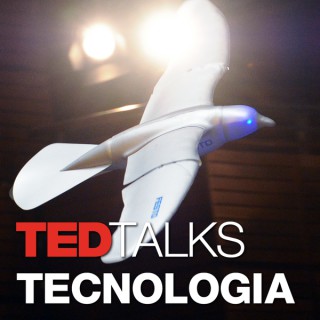Podcast appearances and mentions of karl skjonnemand
- 7PODCASTS
- 7EPISODES
- 27mAVG DURATION
- ?INFREQUENT EPISODES
- Jun 19, 2023LATEST
POPULARITY
Latest podcast episodes about karl skjonnemand
2005. 133 Academic Words Reference from "Karl Skjonnemand: The self-assembling computer chips of the future | TED Talk"
This podcast is a commentary and does not contain any copyrighted material of the reference source. We strongly recommend accessing/buying the reference source at the same time. ■Reference Source https://www.ted.com/talks/karl_skjonnemand_the_self_assembling_computer_chips_of_the_future ■Post on this topic (You can get FREE learning materials!) https://englist.me/133-academic-words-reference-from-karl-skjonnemand-the-self-assembling-computer-chips-of-the-future-ted-talk/ ■Youtube Video https://youtu.be/aYp7wuxZge8 (All Words) https://youtu.be/PHP0e0qlRB8 (Advanced Words) https://youtu.be/SPnUqb7PGtI (Quick Look) ■Top Page for Further Materials https://englist.me/ ■SNS (Please follow!)
The self-assembling computer chips of the future | Karl Skjonnemand
The transistors that power the phone in your pocket are unimaginably small: you can fit more than 3,000 of them across the width of a human hair. But to keep up with innovations in fields like facial recognition and augmented reality, we need to pack even more computing power into our computer chips -- and we're running out of space. In this forward-thinking talk, technology developer Karl Skjonnemand introduces a radically new kind of way to create chips. "This could be the dawn of a new era of molecular manufacturing," Skjonnemand says. Hosted on Acast. See acast.com/privacy for more information.
The self-assembling computer chips of the future | Karl Skjonnemand
The transistors that power the phone in your pocket are unimaginably small: you can fit more than 3,000 of them across the width of a human hair. But to keep up with innovations in fields like facial recognition and augmented reality, we need to pack even more computing power into our computer chips -- and we're running out of space. In this forward-thinking talk, technology developer Karl Skjonnemand introduces a radically new way to create chips. "This could be the dawn of a new era of molecular manufacturing," Skjonnemand says.
당신의 주머니속에 있는 전화기에는 상상하기 힘들 정도의 작은 트랜지스터들이 들어있습니다. 심지어 머리카락 한 올 지름정도의 크기에 3,000개의 트랜지스터가 들어갈 수 있다고 합니다. 하지만 안면인식이나 증강현실 같은 분야의 디지털 혁명을 지속하기 위해서는 컴퓨터 칩에 더 많은 트랜지스터를 넣을 수 있어야 하지만 우리 기술은 한계에 다다르고 있습니다. 이 미래지향적인 강연에서, 기술개발자인 칼 스케넨만은 반도체 제작을 위한 급진적이고 새로운 방법을 소개합니다. "분자 제조 기술의 새시대가 열릴 것입니다."라고 그는 말합니다.
Los chips informáticos autoensamblados del futuro | Karl Skjonnemand
Los transistores que alimentan el teléfono en tu bolsillo son inimaginablemente pequeños: puedes poner más de 3000 de ellos en todo el ancho de un cabello humano. Pero para mantenernos al día con las innovaciones en campos como el reconocimiento facial y la realidad aumentada, necesitamos incluir aún más potencia informática en nuestros chips de computadora, y nos estamos quedando sin espacio. En esta charla con visión de futuro, el desarrollador de tecnología Karl Skjonnemand introduce una forma radicalmente nueva de crear chips. "Esto podría ser el comienzo de una nueva era de fabricación molecular", dice Skjonnemand.
Os chips de computador de automontagem do futuro | Karl Skjonnemand
Os transistores que alimentam o telefone no seu bolso são inimaginavelmente pequenos: você pode colocar mais de 3 mil deles na largura de um fio de cabelo humano. Mas para acompanhar as inovações em campos como reconhecimento facial e realidade aumentada, precisamos incluir ainda mais poder de computação em nossos chips de computador, e estamos ficando sem espaço. Nesta palestra inovadora, o desenvolvedor de tecnologia Karl Skjonnemand introduz uma maneira radicalmente nova de criar chips. "Este poderia ser o alvorecer de uma nova era de fabricação molecular", diz Skjonnemand.
Les puces électroniques du futur s'auto-assembleront | Karl Skjonnemand
Les transistors qui font marcher vos portables dans vos poches sont incroyablement petits : on peut en insérer plus de 3 000 sur la largeur d'un cheveu humain. Cependant, pour suivre les innovations telles que la reconnaissance faciale et la réalité augmentée, on doit employer encore plus de capacité informatique pour les puces de nos ordinateurs - et on n'a presque plus d'espace. Dans ce discours visionnaire, Karl Skjonnemand, développeur technologique, introduit une manière radicale et nouvelle de créer des puces. « Cela pourrait représenter l'aube d'une nouvelle ère pour la fabrication moléculaire,» affirme Skjonnemand.










